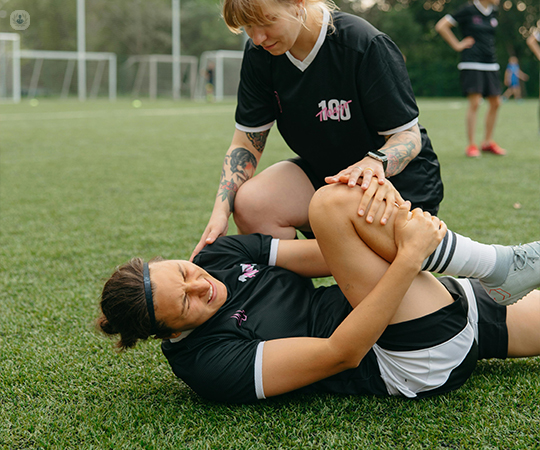What to know about multi-ligament knee injuries
Escrito por:In this article, an orthopaedic surgeon and knee expert explains multi-ligament injuries of the knee, and how they are reconstructed.

What is a multi-ligament knee injury?
Multi-ligament knee injuries (MLKI) can range from mild to severe, depending on the extent of the ligament damage. Ligaments can tear partially or completely, which will affect the degree of pain from the MLKI, and what the best course of treatment will be.
A knee ligament injury is a MLKI when two or more of the four main ligaments of the knee are injured, which are:
- Anterior cruciate ligament (ACL)
- Posterior cruciate ligament (PCL)
- Medial collateral ligament (MCL)
- Lateral collateral ligament (LCL)
A ligament's role in the knee is to provide stability to the knee by anchoring the thigh (femur) and shin (tibia) bones together and ensuring that the knee can the right way and not backwards or to the sides.
Multi-ligament knee injuries are most likely due to torsional force applied to the knee, and can often occur during sports, intense physical activities, or accidents. The knees function as weight-bearing and stabilising structures and can be susceptible to damage due to high impact, strain, and overuse.
What are the signs of a multi-ligament knee injury?
When a MLKI occurs, a patient may experience:
- Knee pain, typically quite suddenly
- Knee swelling
- Difficulty putting weight and pressure on the knee
- A loud popping sound that occurs during the injurious incident.
A knee dislocation is a type of MLKI, but some patients’ knees may not dislocate with a MLKI and will just have tears, or their knee will have dislocated initially but then “reset” itself at some point.
How are multi-ligament knee injuries diagnosed?
To diagnose a MLKI accurately, a full examination of the knee should be confirmed. This will include a review of the incident, a mobility test such as the Lachman test or the posterior drawer test, an X-ray to rule out knee fracture, and followed by an MRI or an arthroscopy so that the doctor can identify which ligaments have ruptured and assess the condition of the nearby tissues such as cartilage, tendons, and blood vessels, as they may have also been damaged in the process. In some cases, a MLKI can be quite dangerous, as it could obstruct the artery behind the knee, or nerve damage
After obtaining the imaging scans and conducting a physical exam, a treatment plan can be devised for the patient.
How are multi-ligament knee injuries treated?
Not all patients will benefit from non-surgical care, which can consist of painkillers, icing the knee, resting the knee, and wearing a brace. This conservative treatment is best for patients with very mild cases. But generally, surgery is recommended so that the patient is not burdened with this injury for longer than necessary and to commence the recovery as soon as possible to restore the full function of the knee, as a ligament injury will not heal entirely without intervention.
Surgery for a MKLI is typically performed arthroscopically, which is a minimally invasive technique where a special scope that has a light and a camera at the end (the arthroscope) is inserted through smaller incisions on and around the knee and may be conducted at the same time as the arthroscopic diagnostic examination.
A reconstruction of the ligaments is required for most MKLIs. A multi-ligament reconstruction involves grafts to reconstruct the ligaments. These can be sourced from the patient themselves, called an autograft, or from a donor, called an allograft. Grafts can be taken from hamstrings, patella tendons, or quadriceps tendons. During the procedure, the damaged parts of the ligaments are trimmed away and the new ones are implanted and secured to the bone via holes drilled into them.
Post-surgery recovery will take several months, and patients will be advised to stay off their leg for at least three weeks. Afterwards, patients can begin with physical rehabilitation exercises and stretches to regain strength and mobility in the knee – this plan should be devised by a physiotherapist. Patients are likely to use crutches or a wheelchair for around two months, and overall complete recovery time when the patient can return to their normal activities unencumbered may be up to nine months.


